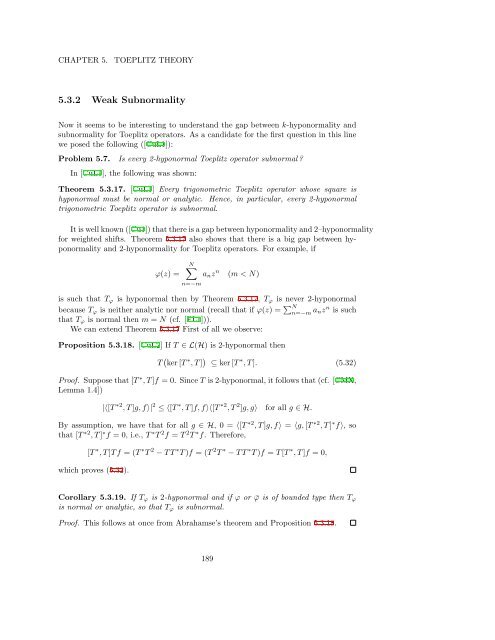Woo Young Lee Lecture Notes on Operator Theory
Woo Young Lee Lecture Notes on Operator Theory
Woo Young Lee Lecture Notes on Operator Theory
Create successful ePaper yourself
Turn your PDF publications into a flip-book with our unique Google optimized e-Paper software.
CHAPTER 5.<br />
TOEPLITZ THEORY<br />
5.3.2 Weak Subnormality<br />
Now it seems to be interesting to understand the gap between k-hyp<strong>on</strong>ormality and<br />
subnormality for Toeplitz operators. As a candidate for the first questi<strong>on</strong> in this line<br />
we posed the following ([CuL1]):<br />
Problem 5.7. Is every 2-hyp<strong>on</strong>ormal Toeplitz operator subnormal <br />
In [CuL1], the following was shown:<br />
Theorem 5.3.17. [CuL1] Every trig<strong>on</strong>ometric Toeplitz operator whose square is<br />
hyp<strong>on</strong>ormal must be normal or analytic. Hence, in particular, every 2-hyp<strong>on</strong>ormal<br />
trig<strong>on</strong>ometric Toeplitz operator is subnormal.<br />
It is well known ([Cu1]) that there is a gap between hyp<strong>on</strong>ormality and 2–hyp<strong>on</strong>ormality<br />
for weighted shifts. Theorem 5.3.17 also shows that there is a big gap between hyp<strong>on</strong>ormality<br />
and 2-hyp<strong>on</strong>ormality for Toeplitz operators. For example, if<br />
φ(z) =<br />
N∑<br />
n=−m<br />
a n z n (m < N)<br />
is such that T φ is hyp<strong>on</strong>ormal then by Theorem 5.3.17, T φ is never 2-hyp<strong>on</strong>ormal<br />
because T φ is neither analytic nor normal (recall that if φ(z) = ∑ N<br />
n=−m a nz n is such<br />
that T φ is normal then m = N (cf. [FL1])).<br />
We can extend Theorem 5.3.17 First of all we observe:<br />
Propositi<strong>on</strong> 5.3.18. [CuL2] If T ∈ L(H) is 2-hyp<strong>on</strong>ormal then<br />
T ( ker [T ∗ , T ] ) ⊆ ker [T ∗ , T ]. (5.32)<br />
Proof. Suppose that [T ∗ , T ]f = 0. Since T is 2-hyp<strong>on</strong>ormal, it follows that (cf. [CMX,<br />
Lemma 1.4])<br />
|⟨[T ∗2 , T ]g, f⟩| 2 ≤ ⟨[T ∗ , T ]f, f⟩⟨[T ∗2 , T 2 ]g, g⟩ for all g ∈ H.<br />
By assumpti<strong>on</strong>, we have that for all g ∈ H, 0 = ⟨[T ∗2 , T ]g, f⟩ = ⟨g, [T ∗2 , T ] ∗ f⟩, so<br />
that [T ∗2 , T ] ∗ f = 0, i.e., T ∗ T 2 f = T 2 T ∗ f. Therefore,<br />
[T ∗ , T ]T f = (T ∗ T 2 − T T ∗ T )f = (T 2 T ∗ − T T ∗ T )f = T [T ∗ , T ]f = 0,<br />
which proves (5.32).<br />
Corollary 5.3.19. If T φ is 2-hyp<strong>on</strong>ormal and if φ or ¯φ is of bounded type then T φ<br />
is normal or analytic, so that T φ is subnormal.<br />
Proof. This follows at <strong>on</strong>ce from Abrahamse’s theorem and Propositi<strong>on</strong> 5.3.18.<br />
189













